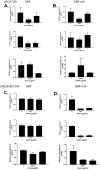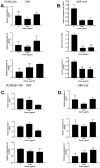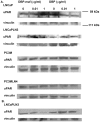Vitamin D binding protein-macrophage activating factor directly inhibits proliferation, migration, and uPAR expression of prostate cancer cells
- PMID: 20976141
- PMCID: PMC2956649
- DOI: 10.1371/journal.pone.0013428
Vitamin D binding protein-macrophage activating factor directly inhibits proliferation, migration, and uPAR expression of prostate cancer cells
Abstract
Background: Vitamin D binding protein-macrophage activating factor (DBP-maf) is a potent inhibitor of tumor growth. Its activity, however, has been attributed to indirect mechanisms such as boosting the immune response by activating macrophages and inhibiting the blood vessel growth necessary for the growth of tumors.
Methods and findings: In this study we show for the first time that DBP-maf exhibits a direct and potent effect on prostate tumor cells in the absence of macrophages. DBP-maf demonstrated inhibitory activity in proliferation studies of both LNCaP and PC3 prostate cancer cell lines as well as metastatic clones of these cells. Flow cytometry studies with annexin V and propidium iodide showed that this inhibitory activity is not due to apoptosis or cell death. DBP-maf also had the ability to inhibit migration of prostate cancer cells in vitro. Finally, DBP-maf was shown to cause a reduction in urokinase plasminogen activator receptor (uPAR) expression in prostate tumor cells. There is evidence that activation of this receptor correlates with tumor metastasis.
Conclusions: These studies show strong inhibitory activity of DBP-maf on prostate tumor cells independent of its macrophage activation.
Conflict of interest statement
Figures







Similar articles
-
RNA interference-directed knockdown of urokinase plasminogen activator and urokinase plasminogen activator receptor inhibits prostate cancer cell invasion, survival, and tumorigenicity in vivo.J Biol Chem. 2005 Oct 28;280(43):36529-40. doi: 10.1074/jbc.M503111200. Epub 2005 Aug 26. J Biol Chem. 2005. Retraction in: J Biol Chem. 2020 Sep 11;295(37):13136. doi: 10.1074/jbc.RX120.015588. PMID: 16127174 Free PMC article. Retracted.
-
Inhibition of angiogenesis by vitamin D-binding protein: characterization of anti-endothelial activity of DBP-maf.Angiogenesis. 2005;8(4):349-60. doi: 10.1007/s10456-005-9024-7. Epub 2006 Jan 7. Angiogenesis. 2005. PMID: 16400520
-
Baculovirus-expressed vitamin D-binding protein-macrophage activating factor (DBP-maf) activates osteoclasts and binding of 25-hydroxyvitamin D(3) does not influence this activity.J Cell Biochem. 2001;81(3):535-46. doi: 10.1002/1097-4644(20010601)81:3<535::aid-jcb1067>3.0.co;2-6. J Cell Biochem. 2001. PMID: 11255236
-
[Mechanism of tumor cell-induced extracellular matrix degradation--inhibition of cell-surface proteolytic activity might have a therapeutic effect on tumor cell invasion and metastasis].Nihon Sanka Fujinka Gakkai Zasshi. 1996 Aug;48(8):623-32. Nihon Sanka Fujinka Gakkai Zasshi. 1996. PMID: 8808830 Review. Japanese.
-
Targeting uPA/uPAR in prostate cancer.Cancer Treat Rev. 2007 Oct;33(6):521-7. doi: 10.1016/j.ctrv.2007.06.003. Epub 2007 Jul 19. Cancer Treat Rev. 2007. PMID: 17658220 Review.
Cited by
-
The association of serum vitamin D-binding protein and 25-hydroxyvitamin D in pre-operative and post-operative colorectal cancer.J Clin Lab Anal. 2020 May;34(5):e23154. doi: 10.1002/jcla.23154. Epub 2019 Dec 13. J Clin Lab Anal. 2020. PMID: 31837045 Free PMC article.
-
Association of functional, inherited vitamin D-binding protein variants with melanoma-specific death.JNCI Cancer Spectr. 2023 Aug 31;7(5):pkad051. doi: 10.1093/jncics/pkad051. JNCI Cancer Spectr. 2023. PMID: 37494457 Free PMC article.
-
Plasma 25-Hydroxyvitamin D, Vitamin D Binding Protein, and Risk of Colorectal Cancer in the Nurses' Health Study.Cancer Prev Res (Phila). 2016 Aug;9(8):664-72. doi: 10.1158/1940-6207.CAPR-16-0053. Epub 2016 May 31. Cancer Prev Res (Phila). 2016. PMID: 27246684 Free PMC article.
-
High glucose and insulin enhance uPA expression, ROS formation and invasiveness in breast cancer-derived cells.Cell Oncol (Dordr). 2016 Aug;39(4):365-78. doi: 10.1007/s13402-016-0282-8. Epub 2016 Apr 22. Cell Oncol (Dordr). 2016. PMID: 27106722
-
GC protein-derived macrophage-activating factor decreases α-N-acetylgalactosaminidase levels in advanced cancer patients.Oncoimmunology. 2013 Aug 1;2(8):e25769. doi: 10.4161/onci.25769. Epub 2013 Jul 29. Oncoimmunology. 2013. PMID: 24179708 Free PMC article.
References
-
- Kawakami M, Blum CB, Ramakrishnan R, Dell RB, Goodman DS. Turnover of the plasma binding protein for vitamin D and its metabolites in normal human subjects. J Clin Endocrinol Metab. 1981;53:1110–1116. - PubMed
-
- Yamamoto N, Naraparaju VR. Vitamin D3-binding protein as a precursor for macrophage activating factor in the inflammation-primed macrophage activation cascade in rats. Cell Immunol. 1996;170:161–167. - PubMed
-
- Kanda S, Mochizuki Y, Miyata Y, Kanetake H, Yamamoto N. Effects of vitamin D(3)-binding protein-derived macrophage activating factor (GcMAF) on angiogenesis. J Natl Cancer Inst. 2002;94:1311–1319. - PubMed
Publication types
MeSH terms
Substances
Grants and funding
LinkOut - more resources
Full Text Sources
Other Literature Sources
Medical

